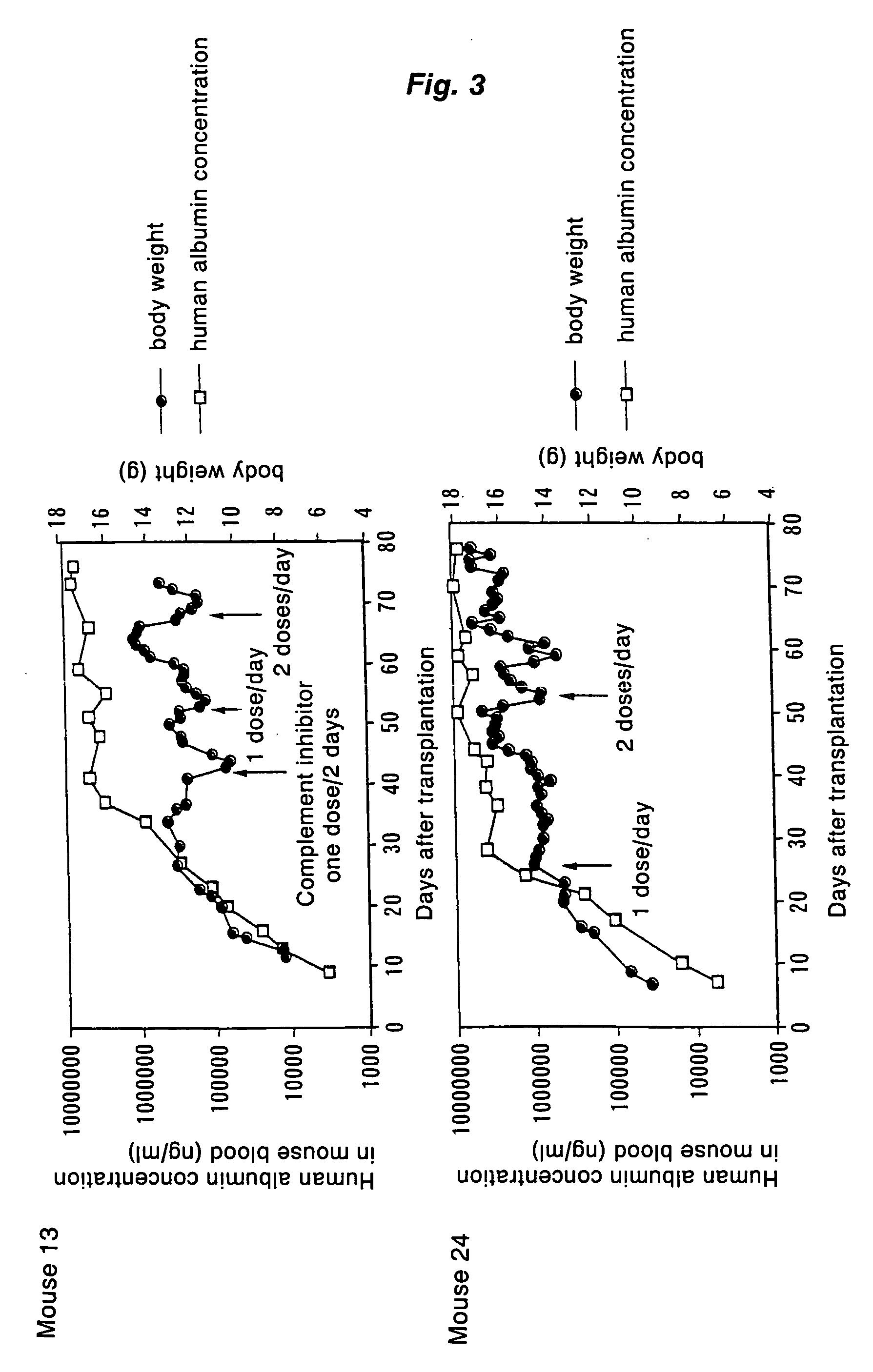Method of proliferating human hepatocytes and method for obtaining human hepatocytes
a technology of human hepatocytes and hepatocytes, which is applied in the field of human hepatocyte proliferation and the method of human hepatocytes, can solve the problems of large amount of livers from brain death patients, long time and effort required in these tests, and huge cos
- Summary
- Abstract
- Description
- Claims
- Application Information
AI Technical Summary
Benefits of technology
Problems solved by technology
Method used
Image
Examples
example 1
Preparation of a Chimeric Mouse Carrying Proliferated Human Hepatocytes
[0123] A chimeric mouse carrying proliferated human hepatocytes in the liver was prepared by transplanting human hepatocytes into the liver of an immunodeficient hepatopathy mouse. Materials and methods for the preparation and the results of the relevant testing were as follows:
1. Materials
[0124] (a) an albumin-urokinase plasminogen activator transgenic mouse (uPA-Tg): B6SJL-TgN (Alb1Plau) 144Bri [0125] (b) SCID mouse (Scid): C.B-17 / Icr Scidjcl [0126] (c) nafamostat mesilate [0127] (d) retrorsine [0128] (e) human hepatocytes
[0129] The mouse (a) and the mouse (b) were purchased from The Jackson Laboratory and CLEA Japan. Co., respectively. The medical agent (c) (brand name: Futhan®) and (d) were purchased from Torii Pharmaceutical and SIGMA Co., respectively.
[0130] The cells (e) were prepared as described below. Before operating hepatectomy, agreement to the informed consent by patient was completed. A norma...
example 2
Separation of Human Hepatocytes from a Chimeric Mouse, and Purification of Human Hepatocytes with a Monoclonal Antibody
[0154] From the chimeric mouse prepared in Example 1, hepatocytes were separated by a collagenase perfusion method. Concentration of collagenase was 0.05%, and treating period was 9 minutes. It was conceivable that hepatocytes was a mixture of human hepatocytes and mouse hepatocytes, however, most of hepatocytes separated (about 80%) were human hepatocytes because cytotoxicity of collagenase is higher for mouse hepatocytes than for human hepatocytes.
[0155] Further, to increase purity of human hepatocytes, only human hepatocytes were isolated using a mouse monoclonal antibody (the monoclonal antibody produced by the hybridoma K8216 in Example 6) which does not recognize mouse hepatocytes but specifically recognizes surface of human hepatocytes. The hepatocytes separated by collagenase perfusion, which contains about 80% of human hepatocytes, were reacted with the a...
example 3
Re-Transplantation of Human Hepatocytes Isolated from a Chimeric Mouse into a uPA-Tg / SCID Mouse
[0156] The hepatocytes isolated in Example 2 were transplanted into another uPA-Tg(+ / +) / SCID mouse, and the transplanted mouse was fed similarly as in Example 1. As the result, increase in human albumin level in mouse blood was observed (FIG. 11).
PUM
| Property | Measurement | Unit |
|---|---|---|
| viable time | aaaaa | aaaaa |
| temperature | aaaaa | aaaaa |
| total volume | aaaaa | aaaaa |
Abstract
Description
Claims
Application Information
 Login to View More
Login to View More - R&D Engineer
- R&D Manager
- IP Professional
- Industry Leading Data Capabilities
- Powerful AI technology
- Patent DNA Extraction
Browse by: Latest US Patents, China's latest patents, Technical Efficacy Thesaurus, Application Domain, Technology Topic, Popular Technical Reports.
© 2024 PatSnap. All rights reserved.Legal|Privacy policy|Modern Slavery Act Transparency Statement|Sitemap|About US| Contact US: help@patsnap.com










